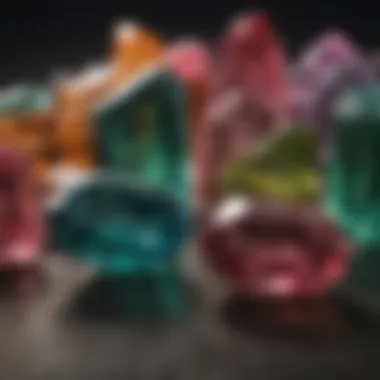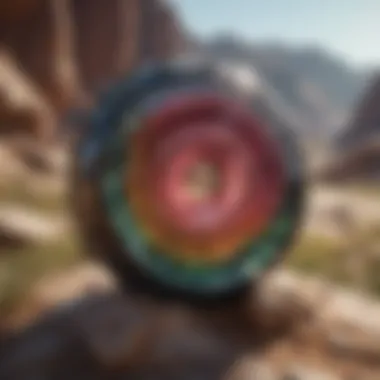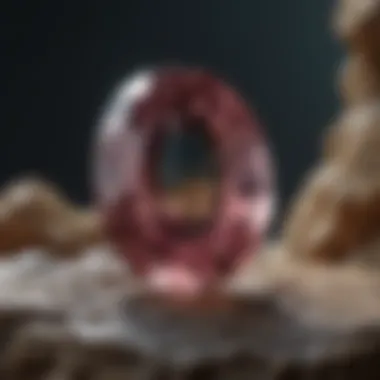Unveiling the Enigmatic Charms of Natural Tourmaline Stone


Rock and Fossil Identification
Discovering the enigmatic wonders of natural tourmaline stone entails understanding its unique characteristics that set it apart from other rocks and minerals. When identifying tourmaline, key features to look for include its distinctive prism-like shape, varying colors ranging from pink, green, blue, to black, and its piezoelectricity and pyroelectricity properties. Utilizing tools such as magnifying lenses and UV lights can aid in the precise identification of tourmaline specimens.
Geological Insights
Delving into the geological underpinnings of tourmaline unveils a deeper understanding of its formation and significance. Tourmaline is primarily found in granite and quartz veins, often forming in pegmatite deposits due to intense heat and pressure underground. Its historical importance traces back to ancient civilizations that valued tourmaline for its purported healing properties and protective attributes. Notable discoveries in the field of geology have revealed new insights into the formation processes of tourmaline and its critical role in Earth's mineralogy.
Preservation and Display
Preserving the beauty and integrity of tourmaline specimens requires employing specialized techniques to prevent degradation and maintain their aesthetic appeal. Proper storage methods involve storing tourmaline away from direct sunlight and harsh chemicals to prevent discoloration and damage. Creative display ideas include incorporating tourmaline into jewelry pieces, using acrylic display cases to showcase intricate details, and arranging specimens based on color gradients to enhance visual appeal.
Collecting Tips and Techniques
Navigating the world of collecting tourmaline involves adhering to best practices to ensure the ethical and safe extraction of specimens. Locating prime collecting sites often involves researching regions known for high tourmaline concentrations, such as Brazil, Afghanistan, and the United States. Safely extracting specimens necessitates using specialized tools like rock hammers and chisels, coupled with techniques to avoid damaging the surrounding geological structures and minerals.
Introduction
Natural tourmaline stone is a mesmerizing gem that captivates the senses and intrigues the mind with its enigmatic allure. This article serves as a comprehensive guide to unlocking the mysteries of natural tourmaline, delving deep into its properties, origins, and significance in various industries. Exploring the formation of tourmaline and its multifaceted uses reveals a world of secrets waiting to be unearthed.
What is Natural Tourmaline Stone?
Composition and Structure
Natural tourmaline stone is a complex silicate mineral renowned for its intricate composition and crystalline structure. With a composition that includes aluminum, iron, and varying trace elements, tourmaline exhibits a unique color range influenced by its chemical makeup. The structural complexity of tourmaline contributes to its vibrant hues and remarkable properties, making it a sought-after choice for jewelry and metaphysical purposes.
Physical Characteristics
The physical characteristics of natural tourmaline stone are as diverse as its color spectrum. From its exceptional hardness and resistance to cleavage to its exquisite lustre and varying levels of transparency, tourmaline offers a distinct appeal to gem enthusiasts and collectors alike. The interplay of these physical characteristics enhances the visual allure and durability of tourmaline, elevating its value and desirability in the gemstone market.
Formation and Occurrence
In the realm of natural tourmaline stone exploration, understanding its Formation and Occurrence plays a pivotal role. This section sheds light on the intricate processes that lead to the creation and discovery of this mesmerizing gemstone. Delving into the depths of the Earth, we uncover the genesis of tourmaline and how geological phenomena intertwine to birth this captivating mineral.
Geological Processes
Crystallization
Exploring the phenomenon of Crystallization within the context of natural tourmaline unveils a crucial aspect of its formation. Crystallization, the process by which atoms arrange themselves in an ordered structure, significantly influences the characteristics of tourmaline. Its unique crystalline structure contributes to its remarkable properties, making it a sought-after choice for collectors and enthusiasts. Despite its advantageous attributes, Crystallization also presents challenges, affecting the final appearance and quality of tourmaline specimens.


Metamorphic Conditions
Diving deeper into the world of natural tourmaline, understanding Metamorphic Conditions provides valuable insights into its origin. Metamorphic Conditions refer to the environmental factors and geological activities that alter the chemical composition and structure of tourmaline. This transformation impacts the appearance and durability of the gemstone, rendering it distinct and prized among its counterparts. While Metamorphic Conditions offer benefits in terms of diversity and uniqueness, they can also pose limitations in certain aspects of tourmaline formation and quality.
Types of Tourmaline
Tourmaline is a mesmerizing gemstone that comes in various types, each possessing unique characteristics that make them highly sought after in the world of gemstone enthusiasts and collectors. Understanding the different types of tourmaline is essential to appreciate the diversity and beauty this gemstone has to offer. In this section, we will delve into the significance of the various types of tourmaline and explore their benefits and considerations.
Varieties and Colors
Tourmaline, known for its vibrant colors and stunning varieties, captivates the imagination of gemstone aficionados. Let's discover the distinctive characteristics of some of the most popular variants of this mesmerizing gemstone:
Black Tourmaline
Black tourmaline, also known as Schorl, is revered for its protective properties and grounding energy. Its deep black color symbolizes power and strength, making it a popular choice for those seeking to ward off negative energies. The key characteristic of black tourmaline lies in its ability to absorb electromagnetic radiation, making it a beneficial choice for individuals working with electronic devices. Despite its impressive protective nature, black tourmaline may sometimes be challenging to cleanse due to its absorptive quality, a factor to consider when incorporating it into your gemstone collection.
Green Tourmaline
Green tourmaline, with its soothing green hues, embodies harmony and balance. This variant is valued for its heart-opening properties and its ability to promote emotional healing and a sense of well-being. The key characteristic of green tourmaline is its connection to the heart chakra, fostering love, compassion, and vitality. Its versatility in jewelry making and its popularity among those seeking emotional healing make green tourmaline a favored choice for both aesthetic appeal and metaphysical benefits.
Watermelon Tourmaline
Watermelon tourmaline is a delightful fusion of pink and green hues, resembling the refreshing colors of a watermelon. This variant is prized for its unique color patterns and its harmonizing energy that balances the emotions and fosters creativity. The key characteristic of watermelon tourmaline is its ability to integrate and align the energies of the heart and base chakras, promoting a sense of inner peace and emotional stability. While watermelon tourmaline's distinctive appearance and metaphysical properties make it a popular choice for jewelry, its rarity and price point are factors to consider for those looking to add this gemstone to their collection.
Rubellite
Rubellite, characterized by its rich pink to red hues, exudes passion, vitality, and courage. This variant is ideal for those seeking to ignite their inner fire and strengthen their sense of purpose and motivation. The key characteristic of rubellite is its association with the root and heart chakras, enhancing one's physical vitality and emotional resilience. Its vibrant color and energetic properties make rubellite a sought-after choice for individuals drawn to its empowering attributes. However, due to its vivid color intensity and potential enhancements in the market, evaluating the authenticity and quality of rubellite gems is crucial when making a purchase decision.
Properties and Characteristics
In this section of the article, we will explore the crucial topic of Properties and Characteristics of natural tourmaline stone. Understanding the properties and characteristics of tourmaline is essential as they play a significant role in defining its value, appearance, and various uses across different industries.
Physical Properties
Hardness and Cleavage
Hardness and cleavage are fundamental aspects that determine the durability and fracturing behavior of tourmaline. The hardness of tourmaline, typically ranging from 7 to 7.5 on the Mohs scale, signifies its resistance to scratches and external abrasions. This exceptional hardness makes tourmaline a favorable choice for jewelry production and ensures longevity in wear.
Moreover, cleavage, or the tendency of a mineral to break along specific planes, is relatively indistinct in tourmaline due to its complex crystal structure. This lack of prominent cleavage enhances the stone's durability and reduces the risk of accidental breakage, making it a reliable gemstone for various applications.


Lustre and Transparency
The lustre and transparency of tourmaline contribute significantly to its visual allure and overall appeal. Tourmaline displays a vitreous to resinous lustre, providing a captivating sheen that enhances its aesthetic charm. This desirable lustre makes tourmaline an attractive option for designing exquisite jewelry pieces that exude elegance and sophistication.
Regarding transparency, tourmaline exhibits a range from transparent to translucent appearances, allowing light to play a fascinating role in its visual display. The transparent varieties of tourmaline, especially those with rich hues like rubellite, showcase the gemstone's internal brilliance and color saturation, making it highly sought after in the gem trade.
Significance and Uses
Natural tourmaline stone holds significant historical and cultural importance, making it a captivating subject of study and admiration. Its unique properties have propelled it from ancient times to modern-day applications, emphasizing its versatility and value across various domains. From jewelry-making to spiritual practices, tourmaline continues to fascinate and serve a multitude of purposes.
Throughout the ages, this gemstone has been revered for its alleged powers to protect against negative energies and promote positive influences. In mythology and folklore, tourmaline is associated with various beliefs and rituals, often symbolizing strength, creativity, and enlightenment. Its rich history intertwines with tales of mysticism and healing, adding to its allure and timeless appeal.
Moreover, tourmaline's symbolism extends beyond mere adornment, transcending into realms of spirituality and holistic well-being. Its vibrant hues and energetic vibrations are believed to align with different chakras, offering balance and harmony to those who wear or interact with it. Symbolizing love, compassion, and inner peace, tourmaline holds a special place in the hearts of many who seek to connect with its profound energies.
Whether as a decorative gem or a talisman of spiritual significance, the multifaceted nature of tourmaline ensures its enduring relevance and uses across diverse cultures and traditions. Its presence in the world of gems and minerals resonates deeply with individuals seeking beauty, meaning, and self-expression.
Mining and Extraction
In the realm of natural tourmaline, understanding the processes of mining and extraction is paramount to unraveling the gemstone's journey from the depths of the earth to its coveted status in various industries. Mining and extraction play a crucial role in bringing this exquisite gemstone to light, contributing significantly to the supply chain and market availability of natural tourmaline.
Global Sources
Primary Deposits
Delving into the specifics of primary deposits in the context of tourmaline mining sheds light on the foundation of this gemstone's sourcing. Primary deposits refer to the locations where tourmaline is found in situ, embedded within the rock formations where it initially formed. These deposits are integral to the understanding of tourmaline's geological history and the diverse conditions that led to its creation. The key characteristic of primary deposits lies in their direct link to the geological processes responsible for tourmaline formation, providing gemologists and researchers with invaluable insights into the gemstone's origins.
Tap into the alluvial wealth of knowledge to glean significant data on tourmaline sourcing!
Alluvial Deposits
On the other hand, exploring alluvial deposits in the landscape of tourmaline mining unveils a different facet of gemstone extraction. Alluvial deposits denote loose accumulations of tourmaline that have been weathered from their original primary sources and transported by natural forces like water currents. These deposits offer a more accessible avenue for acquiring tourmaline, as they are often found in riverbeds, stream sediments, and other surface locations.
The unique feature of alluvial deposits lies in the ease of extraction and collection, making them a favorable choice for miners seeking to acquire tourmaline with less intensive mining processes. However, the disadvantage of alluvial deposits lies in the potential for contamination or mixing with other minerals during the transportation process, affecting the quality and purity of the harvested tourmaline.
Evaluation and Pricing
In the realm of natural tourmaline stone, the evaluation and pricing play a crucial role, offering insights into the value and quality of these exquisite gemstones. Understanding the evaluation and pricing factors is essential for both collectors and industry professionals to make informed decisions. This section will delve into the intricate aspects of evaluating and pricing natural tourmaline stones, shedding light on the key elements that contribute to their overall worth and desirability.
Factors Affecting Value


Color Intensity
Color intensity is a defining factor when it comes to assessing the value of natural tourmaline stones. The vividness and saturation of the color can significantly impact the attractiveness and market value of the gemstone. Intense hues of green, pink, or bi-color variations command higher prices due to their rarity and aesthetic appeal. Gem enthusiasts are drawn to tourmalines with deep, rich colors that exude vibrancy and depth, making them highly sought after in the market.
The unique feature of color intensity lies in its ability to evoke emotions and create visual interest. Gemstones with exceptional color intensity stand out from the crowd, making them a preferred choice for connoisseurs and collectors. However, while intense coloration can enhance the beauty of a tourmaline stone, it's essential to note that overly dark hues may impact the gem's transparency and overall appearance, affecting its worth.
Clarity and Cut
Beyond color intensity, clarity and cut are paramount factors that influence the value and allure of natural tourmaline stones. Clarity refers to the presence of inclusions or imperfections within the gem, affecting its transparency and brilliance. Tourmalines with high clarity levels and minimal flaws are highly prized for their pristine beauty and optical performance.
The cut of a tourmaline gemstone also plays a critical role in determining its value. A well-executed cut enhances the stone's natural luster, maximizes light reflection, and accentuates its color saturation. Precision cuts that showcase the gem's unique color zoning or pleochroism add an element of sophistication and elegance to the final piece.
In summary, the interplay of color intensity, clarity, and cut defines the value proposition of natural tourmaline stones, guiding collectors and buyers in their quest for exceptional gems that stand out for their beauty and craftsmanship.
Caring for Tourmaline
In the intricate world of natural tourmaline stone, caring for these precious gemstones is crucial to maintain their beauty and durability. This section sheds light on the vital topic of maintaining tourmaline, emphasizing the significance of proper care and attention to detail.
Cleaning and Maintenance
Best Practices
Delving into the realm of best practices in cleaning and maintaining tourmaline, it becomes evident that meticulous care is essential for preserving the gem's luster and authenticity. Recognized as a fundamental aspect of gemstone care, best practices entail using gentle cleaning methods and non-abrasive solutions to enhance the stone's longevity.
Opting for best practices ensures the removal of dirt and impurities without jeopardizing the gem's integrity. The meticulous nature of best practices lies in their ability to protect tourmaline from harsh chemicals and excessive pressure, safeguarding its natural brilliance for years to come.
Avoiding Damage
Within the scope of avoiding damage to tourmaline, caution serves as a guiding principle in preserving the gem's elegance and value. By understanding the importance of avoiding damage, individuals can prevent scratches, chips, and fractures that may diminish the stone's allure.
Highlighting the fragility of tourmaline, avoiding damage involves proper storage in soft cloths or jewelry boxes to prevent accidental impacts. Emphasizing prevention over restoration, this approach minimizes the risk of harm, ensuring the gem retains its splendor unblemished.
Conclusion
The conclusion of this in-depth exploration into the mysteries of natural tourmaline stone showcases the profound significance of this gemstone. Throughout this article, we have journeyed through its origins, formation, properties, uses, and care, revealing a wealth of knowledge and insight into the world of tourmaline. Understanding the beauty and practical applications of tourmaline not only enriches our understanding of gemstones but also opens up avenues for innovations in various industries and personal adornment. By delving into the depths of tourmaline, we come to appreciate the complexities of nature and the marvels that it can produce.
Unveiling the Beauty of Natural Tourmaline
Fascinating Insights:
The facet of fascinating insights into natural tourmaline stone unravels the captivating aspects of this gem. Within the realm of gemology, tourmaline's unique composition and stunning variety of colors make it a prized choice for jewelry and collectors alike. The interplay of tourmaline's physical properties with its symbolism and folklore adds layers of intrigue to its allure, making it a gemstone that not only dazzles the eyes but also sparks the imagination. Appreciating the depth of insights tourmaline offers enhances the overall experience of engaging with this remarkable stone.
Endless Possibilities:
Endless possibilities abound when it comes to natural tourmaline stone, showcasing its versatility and adaptability in different contexts. From being a focal point in jewelry to being used for healing purposes, tourmaline's diverse range of applications speaks to its enduring charm and utility. The ability of tourmaline to inspire creativity and evoke a sense of wonder opens up endless avenues for exploration and experimentation. Embracing the endless possibilities that tourmaline presents allows for a continuous journey of discovery and appreciation of the beauty that lies within this enigmatic gemstone.







